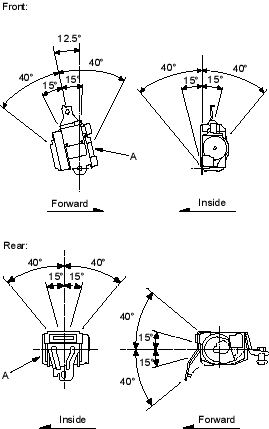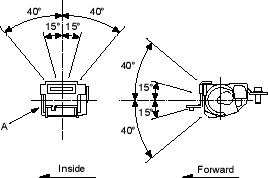For front seat belt retractor with seat belt tensioner, review the SRS component locations (see page 23-23), and the precautions and procedures (see page 23-25) in the SRS section before performing repairs or service.
Retractor
- Before installing the retractor, check that the seat belt can be pulled out freely.
- Make sure that the seat belt does not lock when the retractor (A) is leaned slowly up to 15o from the mounted position. The seat belt should lock when the retractor is leaned over 40o. Do not attempt to disassemble the retractor. The front seat belt retractor with seat belt tensioner is shown, the front seat belt retractor without seat belt tensioner is similar.


- Replace the seat belt with a new assembly if there is any abnormality. Do not disassemble any part of the seat belt for any reason.
In-vehicle
- Check that the seat belt is not twisted or caught on anything.
- After installing the anchors, check for free movement on the anchor bolts. If necessary, remove the anchor bolts and check that the washers and other parts are not damaged or improperly installed.
- Check the seat belts for damage or discoloration.
Clean with a shop towel if necessary. Use only soap and water to clean.
NOTE: Dirt build-up in the metal loops of the upper anchors can cause the seat belts to retract slowly.
Wipe the inside of the loops with a clean cloth dampened in isopropyl alcohol. - Check that the seat belt does not lock when pulled out slowly. The seat belt is designed to lock only during a sudden stop or impact.
- Make sure that the seat belt will retract automatically when released.
- For rear passenger's seat belt on some models (except centre shoulder belt), make sure that the locking mechanism in the seat belt retractor will engage when the seat belt is pulled all the way out.
- Replace the seat belt with a new assembly if there is any abnormality. Do not disassemble any part of the seat belt for any reason.

